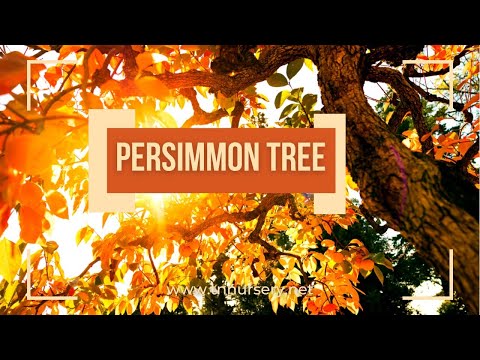Fruiting Persimmon Tree- Diospyros Virginiana
The Persimmon Tree is a common fruit, widely regarded as a gem for its delicate, sugary-sweet flavor. However, two types of Fruiting Persimmon Trees bear this fruit. The Japanese Persimmon Tree and the American Persimmon Tree are native to the southeastern United States. They are utterly perfect in a garden where they can be picked and eaten within minutes.

Fruiting Persimmon Tree Details
Family: Ebenaceae
Light Requirement: Full sun, partial sun
Water Needs: Moderate
Height: 30-80 ft
Spread: 20-35 ft
Growth Rate: Moderate
Soil Preference: Clay soil
Season of Interest: Spring/Summer, Fall
Flower Color: Gold/Yellow
Fruit: Persimmons
Wildlife Value: Mammals, birds, insects, and Honeybees
Notable Characteristics of Fruiting Persimmon Trees
The tree has a mass of interwoven branches that make a lush canopy of foliage. Its leaves are oval-shaped and long, with a glossy, dark green finish. The bark is thick and dark grey, with deep grooves; it has a somewhat scaly texture similar to that of oak tree bark.
In autumn, the green foliage transforms into a sea of brilliant orange, yellow, and red, while the fruit matures and ripens. The bright orange fruit of Fruiting Persimmon Trees can even hang on to the branches after the leaves have fallen off, giving the tree a mysterious, haunting look.
Landscape and Maintenance of Fruiting Persimmon Trees
This magnificent tree thrives in full sun but can also grow well in partial sun. It grows best in well-draining, fertile, loamy soil that is even slightly acidic. Fruiting Persimmon Trees don’t need much water, only around an inch per week, which is a very moderate rate, and can even be drought-tolerant.
As a native of the southwestern United States, this tree can withstand a variety of climatic conditions and is fairly cold-hardy. The beautiful fall colors and late-season ripening fruit make this tree a perfect addition to your garden and your kitchen.
Persimmon Tree FAQ
How fast do persimmon trees grow?
They trees grow at a moderate rate, typically adding 1–2 feet of height each year once established. Their steady growth produces a strong trunk and dependable fruiting.Do you need two persimmon trees to produce fruit?
Most trees benefit from having two for heavier production, though some varieties can self-fruit. Planting more than one improves pollination and increases yield.What type of soil is best for persimmon trees?
They thrive in well-draining, slightly acidic soil. Persimmons tolerate clay and sandy soils as long as excess water does not stay around the roots.How much sunlight do persimmon trees need?
Full sun is ideal. More light leads to more abundant blooms and fruit throughout the growing season.How long does it take for a persimmon tree to produce fruit?
Most begin producing fruit 3–5 years after planting, depending on conditions and variety. Consistent watering and sunlight help speed fruiting.Are persimmon trees drought-tolerant?
Once established, persimmons are tolerant of dry conditions. Young trees need regular watering to develop a deep, healthy root system.Do persimmon trees attract wildlife?
Yes. The fruit attracts deer, foxes, raccoons, birds, and other wildlife. Their sweet fall fruit makes them a favorite in naturalized areas.Are persimmon trees cold-hardy?
They are cold-hardy and handle winter temperatures with ease. Mulching the base in late fall helps protect roots in extremely cold regions.Why are my persimmons dropping early?
Early fruit drop is usually caused by inconsistent watering, nutrient imbalance, or high heat. Keeping the soil evenly moist often helps reduce drop.l do persimmon trees get? Mature American persimmons typically grow to 30–60 feet tall, depending on the variety. Their upright form and fall fruit make them a beautiful feature tree.

Exposure
Persimmon trees thrive in full sun, requiring at least six to eight hours of direct sunlight daily for optimal growth and fruit production. While they can handle part shade, complete sun ensures the best development of their sweet, flavorful fruits.
Height at Maturity
Over 25 Feet
Usage
Fruit
Shipped As
Bare-root
Ships
UPS
Planting Zones
4-9





